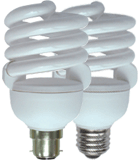
Electricity Usage:
Because they can use up to 80% less electricity, they are much more efficient. However,
like all flourescent lights there is a short warm-up time until they reach operating
temperature and full light output. During this warm-up phase they are not at maximum
efficiency. So, if you only use them for short periods (e.g. in a toilet), then their efficiency
will be less.
The package will tell you how much electricity they use but, as noted below, things vary. A
CFL lamp that is equivalent to a 100W incandescent lamp might be described as 20W
or 18W. The latter might simply be more efficient, or it might put out slighty less light but
as efficiently as the other, depending on the make and model.
Bulb Life:
The life of a bulb is determined by its design/manufacture and by the environment it is
used in.
Incandescent lamps have been around for almost a century, so they are comparatively
standardised - standard design lives are 1000-hour and 1500-hour, though you will
usually struggle to find the 1500-hour type in New Zealand. 'Design life' means that they
have been designed, manufactured tested to achieve an average of the design life - due
to manufacturing tolerances some will last longer and some not. In a typical residential
environment you will get the design life, but not in hotter (downlight) or colder (external
security light) situations. Reputable supermarket brands are usually 1000-hour, but be
careful - "budget" or "house" brands may be built to a price rather than to a life - if the
package isn't clear about design life, then "you get what you pay for".
Compact flourescent lights are relatively new and there is little standardisation yet.
Standard design lives commonly seen include 4500-hour, 6000-hour and 10,000-hour.
However life is often expressed as years, based on the light running for an average of 3
hours per night, so that one year is approximately 1000 hours. You will also see life
expressed as so many incandescent bulbs - e.g. 6000-hours = 6 "ordinary bulbs". Finally,
watch out for the words "up to" 6000 hours - this is less than an "average of" 6000 hours.
When in doubt, stick to reputable brands.
A side benefit from long life is the reduced number of times someone is at risk of a
sprain, concussion, broken bones, or worse, from falling while changing a bulb. For this
reason CFLs are ideal for those hard-to-reach locations, particularly where elderly
people are involved.
Cost:
It isn't eay to compare with one option, something else that is dearer to buy but cheaper
to run and which lasts a lot longer - causing inflation and cost-of-money issues to come
into play. Variables that determine the result include the purchase price of both, the
running cost of both, the life of both, and the "cost of money".
There is a calculator at http://www.ecobulb.co.nz/MoneySavingCalc.aspx which helps
you to work out the saving in your situation, but it doesn't appear to include the cost of
money.
Following is a table of calculations, based on the following parameters:
Purchase price of 100W incandescent lamp: $1.00 - typical Dunedin supermarket price,
June 2005
Average life of incandescent bulb: 1000 hours, unmarked but reputable brand
Purchase price of equivalent compact flourescent lamp: $5.95 - Countdown supermarket,
Dunedin, June 2005
Average life of compact flourescent lamp: 6000 hours standard
Variable residential electricity price: 15 cents per kilowatthour (i.e. per unit)
Discount rate (for cost of money): 7% per annum
Inflation (bulb prices and electricity price): zero
Time on per night
Average cost of 100W incandescent lamp per annum
Cost Saving from equivalent CFL
10 mins $1.01 29% 20 mins $1.98 54%
30 mins $2.94 63% 1 hour $5.88 69%
2 hours $11.70 73% 4 hours $22.90 74%
Style?
Absolutely! . CFLs are available in many styles
Isn't it amazing that some will prefer to pay the higher cost of
cheap incandescent bulbs, even if this is akin to
"burning money".
WE LOVE
VERBAL
GRAFFITI !
|
HouseWifeMafia.com ~ The eMagazine For Women
|
LIFE ON EARTH
Brought to you by Earth' s Promise Farms
Sandee Corlett
|
PEAS take a moment to click on our sponsors
to do a bit of your shopping!
This will help us enormously in bringing you
eggstra special stuff each week!
Get it - eggstra - ha ha ha
Thank Ewe!
|
Here are some key facts:
- For the same light output, they save up to 80% of the electricity an
incandescent bulb would use.
- They last much longer, but their life varies by make and model.
Additionally, longer life = reduced risk changing bulbs.
- They cost more to buy, but less to run and are lower-cost overall.
- They don't work with most light dimmers,
- They have a short warm-up time to reach full brilliance.
Adopting this tiny little lifestyle changed makes you
sassy, chic, earth friendly and richer too!
Ah yes - I know you are fabulous! Be comfortable with your own fabulousness and maybe you will inspire others to follow your path.
Check out the video!








